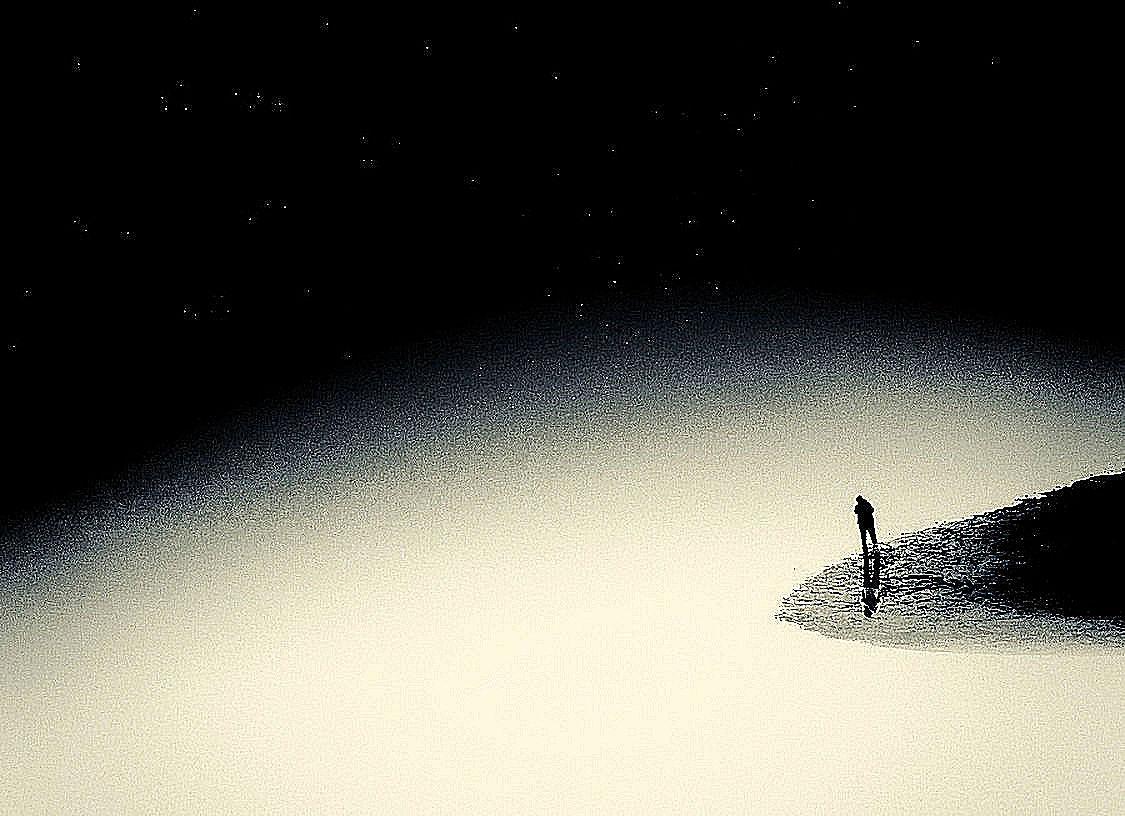Home › Forums › Time Space Knowledge › Let me Count the Ways
Tagged: beginnings, birth, light-years.universe
- This topic has 1 reply, 2 voices, and was last updated 02/09/2023 at 11:27 AM by David Filippone.
-
AuthorPosts
-
-
February 9, 2023 at 5:51 am #1160

Edge of the Future – Image by GlamSci
Let me count the ways in which the world eludes enumeration and understanding. Trying to hold a steady image feels like peering into a facet of a crystal spinning in a window. In one sense, I can see in several directions at once and therefore glimpse more than what lies directly in front of me. In another sense, everything is scattered so that nothing appears clearly and unambiguously.
People sometimes use the image of a crystal spinning in a window to depict the multi-dimensional, shifting world in which we live. Sunlight scattered into spinning shafts of colored light captivates the senses, but doesn’t help to maintain a stable reality. This doesn’t trouble me if I am just walking past, secure in the conviction that the coffee pot is waiting for me just down the hallway. I just take those scattered images as a pleasing light show, since if I tried to base my next move on such an unstable picture of the world, I might feel lost, or even threatened. So, like everyone I know, I base my next moves on what showed up last time in an unquestioned belief that it will again.
I sometimes try to look inwards and outwards at the same time. Looking inwards, I encounter a body comprised of organs, coordinated systems, atoms, and—I’m told–sub-atomic particles, all in a field that is mostly empty. Inside, I also see clouds of thoughts, feelings, sensations, and shifting emotional climates too cloudy and evanescent to ever hold firmly in place.
Looking outside, things are scarcely clearer, notwithstanding the massive industry of scientific study dedicated to producing authenticated depictions of our world.
When we hear that the James Webb Space Telescope is capturing images of galaxies in sharper detail than anything before, we are likely to feel impressed that scientific exploration of the cosmos is unfolding before our eyes. And hearing that among those images are pictures from just after the universe had been sprung into being, we may try to follow the narrative of these explorations, even though we lack the scientific training to really comprehend the details.
I can appreciate the idea that the farther away an image is, the longer ago it must have occurred, since light from a distant event takes time to reach us. For instance, the light from the Sun arrives here after a journey of 8 minutes. Of course, 8 minutes is not the same as the age of the universe, but it seems logical that images that occurred a few blinks after the birth of our universe, like light from our own Sun, also took time to reach us, just a lot more.
It’s easy to get caught up in a spirit of discovery, as if the mysteries of the cosmos are being slowly peeled back. But it can also feel like playing with a Lego set from a box labeled “Cosmic time and space”. I don’t doubt that light is traveling at 186,000 miles per second. But I have no way of visualizing such amazing speed. If light really travels that fast, imagine how far it must travel while I get up now and pour myself a cup of coffee?
Well, it took me a bit longer than I planned because the coffee pot was empty and I had to boil some water for instant coffee. But now I’m back and ready to count the miles.
I just googled a few facts about cosmic time and space. Who would have thought? Light doesn’t just skim around the universe like a kid at a skateboard park. Even a little way out into the universe, still well within our own galaxy, astronomers don’t measure distances in terms of miles. They use “light years” (the distance travelled by light during an entire year–about 6,000,000,000,000 miles) as their ruler. It turns out that even Alpha Centauri, our closest neighbor, clocks in at 4 light years away; so, even light coming from objects that are just the tiniest bit out into the universe takes years to reach us.
Scientists tell us that telescopes are taking snapshots of a universe that existed just after the Big Bang, 13,400,000,000 years ago. So, light had to travel a vast number of miles (the age of the universe times the speed of light) to reach us. That comes to a number with almost 100 zeros.
What can we do with this information? Can we compare it to the distance walked by the Buddha during his 80 years of life? After all, in both cases we just multiply speed of movement by how much time elapsed.
Does it make sense to call the source of that light “the edge of the universe”? How can we speak of a source that no longer exists, and hasn’t existed for 13 billion years? If it no longer exists, then where is it now? Looking at these images, which seem like other astronomical images, what does it mean to say that they come from a time long before the present universe came into existence, with us in it peering into boundless space? What does it mean that the further we peer out into this universe, the farther we are from our current time? Are we just peering into nested bubbles of light, like eggshells of time, where each one once broke open, was present, flourished and ceased to exist, longer and longer ago?
The logical construct that relates spatial distance to the amount of time elapsed dissolves before our eyes, when we realize that images from the beginning of our universe have no path of continuity connecting them to the universe that exists right now.
Perhaps counting is not be the best way after all, to get closer to creation and its unfolding song of forever and ever. If we throw in that we need to be alive and conscious in the stream of time even to wonder if there was a beginning, what would it mean for there to have been a beginning when there was no conscious presence present to observe it? What could it mean for there to have been a birth out of nothing which, like a baby that never grows up, has been expanding ever since?
What would it feel like if there was a beginning every moment? And if we noticed such a thing, would we then fall into nesting spheres of wonder?
“There are questions that can activate this expansion: active agents of the Body of Time. What is beyond the cosmos? What does light reveal when there are no objects to reflect it? Where can we go if ‘from’ is fixed with ‘to’? What properties do we discover when nothing appears? What meaning does our life assume when there are no more stories to tell?”
…’Dynamics of Time and Space’, Tarthang Tulku. p.164 -
February 9, 2023 at 11:27 am #1162
Hi Michael,
I love your inquiry, perhaps inspired by the quoted questions that Rinpoche posed:
“What is beyond the cosmos? What does light reveal when there are no objects to reflect it? Where can we go if ‘from’ is fused with ‘to’? What properties do we discover when nothing appears? What meaning does our life assume when there are no more stories to tell?”
Rinpoche goes on to suggest: “When the structures of linearity collapse into nuclear time, we inhabit the inwardness of time.” It seems natural to me to inquire of that openness: How does that feel? Ordinarily we focus-in, narrowing down, because as you say: “[Everything] is scattered so that nothing appears clearly and unambiguously.” And consequently, we don’t usually value that view, so we skip our attention over it in order to fixate a view we feel is anything but ambiguous. Because it feels more familiar and safer. I am reminded of some TSK practices designed to counter the devaluing of that seemingly ‘ambiguous’ or more open perspective. For instance, excerpts here…
TSK Ex. 29 – Awareness as a Reflective Surface, in which we are invited to: “Instead of manipulating your ‘mind’ or knowing capacity so as to seize upon objects and thereby know them, simply allow all objects to ‘be known’. At first, this amounts to adopting a more passive role than usual, conceding the active role to the perceived objects . . . they present themselves to your awareness. It is as though you, the subject, have become a neutral, reflective medium, like a mirror or the surface of a lake. Everything that draws near is accepted and reflected without your awareness itself doing anything, or changing in any way as a result of its responsiveness.”
Also related is…
DTS Ex. 22 – Return to Light, “…look within your thoughts and sensations for the quality of darkness. Become familiar with darkness; be ready to let yourself sink into it without losing awareness completely. Gradually you will be able to sense fluctuations within the dark: moments that are more luminous, when experience seems lucent and free. The quality is one of shining through, of a delightful aliveness. To dwell within these moments is to engage a familiarity with light that makes its own path…
Despite what the voices of ordinary experience may say, light is never far away. If our experience exhibits darkness, it is self-constructed. It is as though we had built a box of light, then climbed inside and closed the cover. Now we insist that we are surrounded by darkness, choosing to ignore that the box that shuts out the light is also made of light.”
So it seems the value of your questions, and the practice of TSK, is that they open that narrow focus on ordinary experience, allowing us to look within our own constructed constellations of mind, into their open source, and that we might feel that quality of light shining through, and learn to value it too. Rinpoche writes:
“In terms of our daily concerns, such investigation might prove extremely valuable. If emotionality and confusion could resolve into a space-like openness, the quality of experience could shift dramatically. Interpreting the mind in such terms might allow a different kind of knowledge, accommodating a ‘field’ of mental activity that could support more positive or complete forms of ‘minding’. Seeing mind as space or opening to space as alive with knowing might encourage new forms of experience: more vivid and fiery, more sharp and clear, more flowing and receptive, or more stable and balanced.” KTS p. 162
-
-
AuthorPosts
- You must be logged in to reply to this topic.
